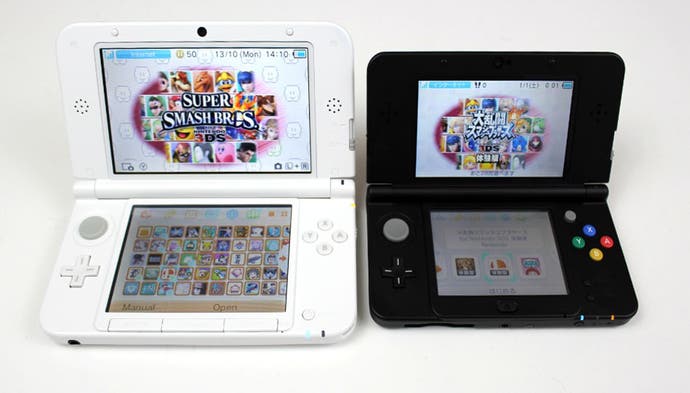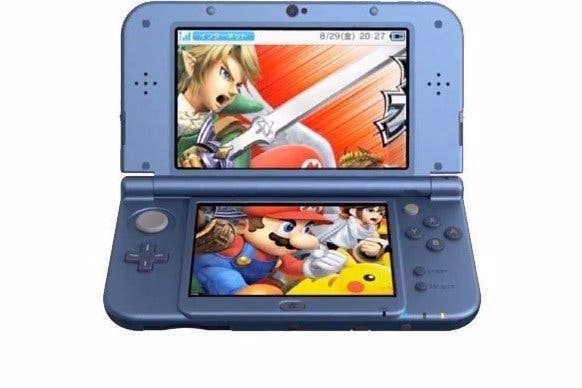Face-Off: Nintendo 3DS vs New 3DS
Just how much faster is the later model? Finally, we have answers.
Hyrule Warriors arrived on Nintendo 3DS this week, around 18 months after its Wii debut - and it's something of a rare breed of title. It's one of the few 3DS titles that exercises the additional power of the New 3DS, which in turn represents something in the way of unfinished business for Digital Foundry. We know that Nintendo's refreshed handheld boasts a significant increase in power compared to the launch model, but just how much more capable is it?
Getting a firm idea of the performance differential between the two handhelds has been something we've been eager to test for a long time now, and while we have access to an older 3DS 'Nitro' kit, which allows for capture, we don't have a New 3DS equivalent. However, capture kits and hardware mods are available to get the job done, using the same core technology found in our modified PlayStation Vita. YouTuber Tilmendomination owns such a device, and provided the captures that made this article possible.
But first, let's talk core specifications. It's safe to say that the 3DS isn't exactly the most powerful piece of gaming hardware on the block. Based on specs found on 3DBrew, derived from hacking and reverse-engineering the hardware, the initial iteration of the 3DS featured a dual-core ARM11 CPU clocked at 268MHz, along with a second ARM core running at 134MHz.

Graphics duties are taken care of using a DMP PICA processor, again clocked at 268MHz. It was a remarkably old GPU, even for its time, lacking the kind of programmable pixel shaders we've seen since the launch of Xbox 360. However, it does have a number of fixed function blocks capable of handling per-fragment lighting, hard and soft shadowing, bump-mapping, procedural textures and even the rendering of 'gaseous objects'. Additionally, custom hardware also accelerates geometry processing.
It's something of a hardware lightweight though, and its library is effectively a triumph of software design overcoming some brutal limitations. Nintendo in particular has extracted magic from this meagre spec, to the point where titles like Mario Kart and Super Smash Bros compare favourably to their Wii U counterparts.
However, the New 3DS represents a significant leap forward - unfortunately, the GPU offers no improvement in any way whatsoever, but the main ARM processor is upgraded to a quad-core model, CPU frequency can increase to 804MHz, plus there's much more memory, opening the door to advantages such as shorter loading times, and higher detail textures. Specifically, system RAM doubles to 256MB, the GPU receives an extra 4MB of VRAM, while there's also some extra L2 cache on the CPU.
So how does this all translate to the gameplay experience? We'll kick off with a look at this week's key release - Hyrule Warriors.
This Wii U port only exercises one key element of the 3DS spec bump - the processor upgrade. In terms of the graphical make-up of the game, nothing has changed, but in terms of the gameplay... well, that's a whole different story. New 3DS is something of a game-changer, offering up a 50 per cent overall improvement to performance. Running Hyrule Warriors on an old 3DS, gameplay sticks at the 20fps level throughout, sometimes dipping beneath and occasionally hitting 30fps.
By contrast, New 3DS offers up something approaching a locked 30fps throughout the experience. In fact, it even runs more smoothly than the original Nintendo Wii U version, which often struggles to maintain its 30fps cap - a remarkable state of affairs for a game based on the Dynasty Warriors engine, originally designed to operate at 60fps.
There's the sense that the developer has principally targeted the more modern 3DS here, with less consideration to those with older hardware - 20fps for a fast-moving action game isn't great and it's an often disorientating experience. However, compromises have been made even for those with the latest kit - loading times aside, there's little in the way of further enhancements. The additional memory results in no tangible upgrade to the visual experience, but the frame-rate upgrade is highly worthwhile - and by all accounts, Rodea: The Star Soldier is another 3DS title offering a similar boost on the more recent 3DS hardware [UPDATE 27/3/16 13:34: We've just received word that Rodea actually runs at the same 20fps frame-rate on both units - this exhaustive thread has more of a detailed breakdown on New 3DS support.]
The same can't be said for Monster Hunter 4 Ultimate - the showcase game for the New 3DS on its Japanese launch, and still one of the most impressive utilisations of the revised hardware. Benefits offered here move beyond the silicon alone - the New 3DS essentially integrated the controversial Circle Pad Pro into the main unit, and it's essential for this title.
The benefits of the internal hardware boost are two-fold - unlike Hyrule Warriors, New 3DS owners do actually see a substantial bump to the quality of the visuals, with enhanced textures adding significantly to the overall presentation, though the full effectiveness is curtailed somewhat owing to the still-crude 400x240 resolution. However, there are no other upgrades, highlighting the lack of change in the GPU hardware design between the two 3DS revisions.
However, performance sees an upgrade on par, if not better than that seen in Hyrule Warriors. The older 2DS is no slouch - it hands in a read-out in the 30fps area, but the game is running unlocked, so the game does lack some consistency in its update. The fact that is there is no bar on performance beneath the 3DS panel's 60Hz refresh extends to the same code running on New 3DS too, where we find a performance bump even more impressive than Hyrule Warriors - gameplay sees anything from a 50 to 66 per cent uplift, bringing gameplay up to 45-50fps. Curiously though, engine-driven cut-scenes see very little improvement.
Software exclusive to the new 3DS is thin on the ground - to be expected perhaps when the userbase is dominated by owners of the older hardware revision - and that's something of a shame based on the quality of Xenoblade Chronicles, a port of the classic open world Wii title, and the most high-profile New 3DS exclusive. Put simply, if you already own Nintendo's top-tier 3DS, you really must check this out. It's an uncanny conversion.
Resolution aside, there's one key compromise in effect here - texture quality, where the detail level is clearly lower than the Wii original. However, it doesn't really matter that much owing to the fact that it's a handheld game. The media on this page can put a rather brutal spin on the shortcoming of Nintendo's handheld - and the same thing happened when we stacked up PlayStation Vita against PS3 - but in hand, the smaller screen manages to mitigate many of the compromises, be they detail or even performance-related.
Certainly, the cutbacks elsewhere are minimal. To all intents and purposes, this is effectively the same game - the title is feature-complete in terms of content, the environments and characters are left untouched in terms of geometry levels and even effects-work is a match. The developer makes some compromises in terms of level of detail (LOD), so you do see more pop-in on objects are you traverse the environments, but again, the smaller screen helps to make a small issue become more of a non-issue during actual gameplay.
Frame-rate is also highly impressive too. The Wii version sticks fairly doggedly to its 30fps target, and New 3DS does a remarkable job in following suit during gameplay - especially in traversal sections. GPU-stressing effects - in particular transparent alpha textures - do cause issues for the New 3DS though and this can impact the experience a little during combat. Otherwise though, the hit occurs mostly during cut-scenes where the player is passive, so aside from a little judder, there's not really a tangible hit to the overall experience.
Xenoblade Chronicles is a remarkable achievement - the most technologically advanced Nintendo handheld game we've played, but alas, also something of an outlier for New 3DS, standing apart from the crowd in terms of its unrestrained utilisation of the more powerful hardware. You can't help but wonder how the quality of 3DS titles would have improved across the board if Nintendo had gone with this design right from the get-go.
After all, the spec revision doesn't actually introduce any new technology as such - there's just more RAM, more CPU cores and a clock-speed boost. The fact that we still see such impressive performance boosts when the GPU component apparently remains completely unchanged from one 3DS to the next is hugely revealing - it tells us that the initial launch hardware was unbalanced, that the GPU was left severely under-utilised, owing to a severe lack of CPU resources. Very possibly this was down to the fact that battery life was a real issue - we assume that the New 3DS takes advantage of a smaller process node for its hardware.
As things stand, existing 3DS titles see no performance bump when running on New 3DS hardware, even those with unlocked frame-rates. Unless the software asks for the additional power, the New 3DS simply runs at the old version's speed - though you do get loading time improvements from the larger pool of RAM. That hasn't stopped hackers with custom firmware kicking in New 3DS's 804MHz speed on older 3DS content. Unfortunately, this is something we couldn't test, but there are reported improvements on titles such as Pokemon XY (which ran poorly), Monster Hunter 3U and Luigi's Mansion 2 (unlocked frame-rate), Ace Combat 3DS (unlocked frame-rate). Curiously, you can also downclock New 3DS to old 3DS's 268MHz clock-speed, and not surprisingly, Xenoblade is crippled as a result.
Overall then, putting this comparison together has been a hugely instructive and enjoyable exercise - but we can't help but feel some level of regret that what is a clearly substantial revamp of the hardware never really gained the traction it deserved in terms of software support. Just how many games were held back from being the best they possibly could have been owing to the initial model's weak CPU? As Nintendo transitions towards its NX hardware, hopefully the designers can get the hardware balance right on the first try.





